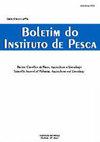THE INFLUENCE OF THE COASTAL CURRENT ON THE ESTIMATION OF RELATIVE ABUNDANCE INDICES IN SMALL-SCALE SHRIMP FISHERY
IF 0.6
4区 农林科学
Q4 FISHERIES
引用次数: 0
Abstract
The aim of this scientific note was to evaluate the influence of the coastal current on the estimation of relative abundance indices for small-scale marine shrimp trawling to indicate the best relative abundance index to be used for stock assessment and conservation. Georeferenced experimental trawls were carried out with standardized equipment and capture time on the coast of Rio Grande do Norte, northeastern Brazil. Drags followed convergent and divergent orientations in relation to the flow of the local coastal current. The results showed that the direction of the coastal current flow directly influences the distances and drag shifts, generating variations in the sampling effort and, consequently, bias when using Catch per Unit Effort (CPUE) as a relative abundance index. Conversely, the adoption of Catch per Unit of Swept Area (CPUA) as an index of relative abundance for shrimp trawling becomes more suitable since the variations in the distances of trawl shifts are perceptible through this index.沿海洋流对小规模对虾渔业相对丰度指数估算的影响
本科学说明的目的是评价沿海洋流对小型海洋对虾拖网捕捞相对丰度指数估算的影响,以指出用于种群评估和养护的最佳相对丰度指数。地理参照实验拖网采用标准化设备和捕获时间在巴西东北部的北里奥格兰德州海岸进行。相对于局地海岸流的流动,拖曳遵循辐合和发散方向。结果表明,沿海洋流的方向直接影响距离和拖曳位移,从而产生采样努力的变化,从而在使用单位努力渔获量(CPUE)作为相对丰度指标时产生偏差。相反,采用每单位清扫面积渔获量(CPUA)作为虾类拖网捕捞相对丰度的指数更为合适,因为通过该指数可以看出拖网移动距离的变化。
本文章由计算机程序翻译,如有差异,请以英文原文为准。
求助全文
约1分钟内获得全文
求助全文
来源期刊

Boletim do Instituto de Pesca
FISHERIES-ZOOLOGY
CiteScore
0.80
自引率
0.00%
发文量
24
审稿时长
>12 weeks
期刊介绍:
To publish original articles of research and short communications in the following áreas: Fisheries, Aquaculture, Zootechnology, Limnology, Oceanography, Biology and Pathology of aquatic organisms. The publication depends on the approval of the Editorial Board, based on the peer review.
 求助内容:
求助内容: 应助结果提醒方式:
应助结果提醒方式:


